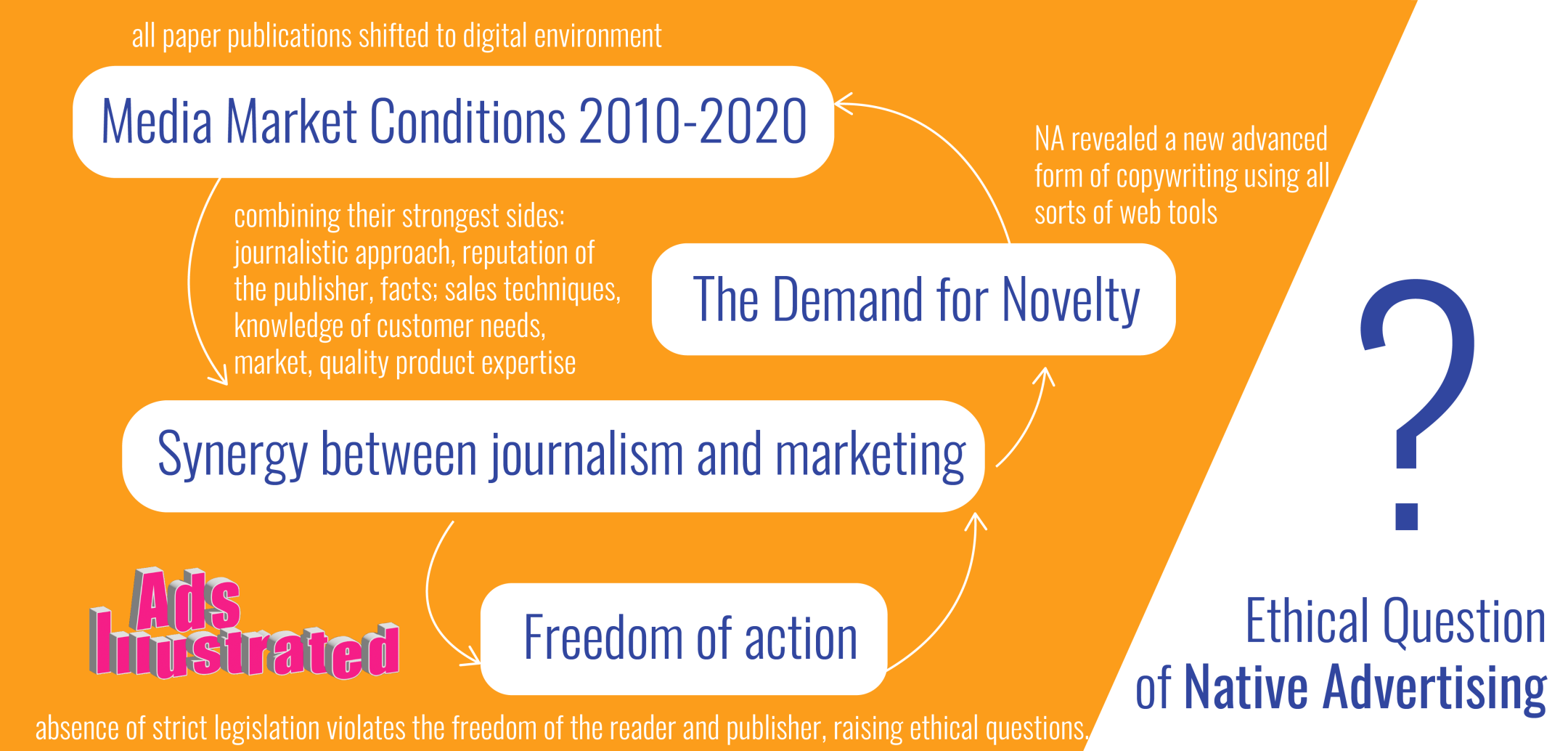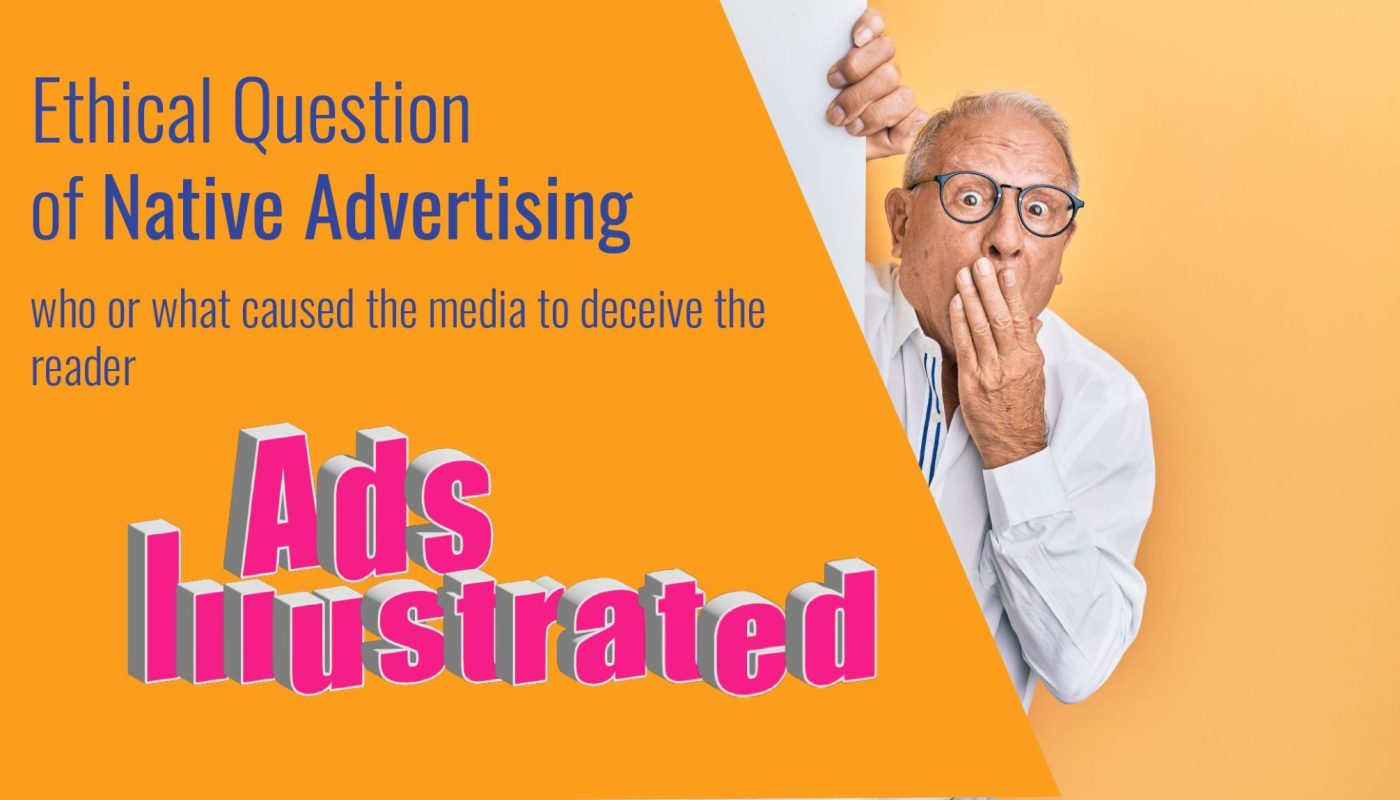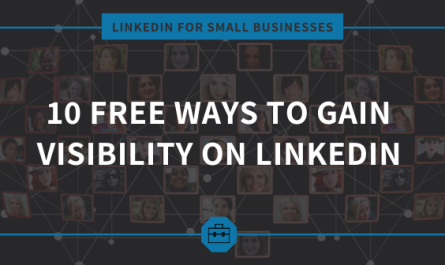As the principle of nativity increasingly pervades various types of advertising, questions arise about how native advertising is perceived and processed in consumers’ minds, and how much of its effectiveness relates to the fact that consumers are not aware that such content is advertising at all.
The ethical problems with native advertising lie in its nature and the following reasons for its appearance.
Media Market Conditions 2010-2020
With the advent of the Internet, by 2015 almost all publications had moved to the online environment and, either reduced the print version of their publications to a minimum or ceased to exist on paper altogether. Whereas in the print era, the media business made its money on subscriptions and advertisers, who could not accurately assess the effectiveness of placements, had no alternative, the electronic environment offered not only a wide choice of new competing publications, but also performance and control indicators that were accurate and expressed in concrete numbers (shows, reading time, conversions). Banner formats, which had already existed for about 15 years since the early noughties, had by now lost their novelty, had “washed out” with “banner blindness” and had become ineffective (0.05%, of which some clicks are incidental (Chaffey, 2019). The media market demanded new ways to monetize publications.
The demand for novelty
Native advertising revealed a new format not yet familiar to the reader, representing a more advanced form of copywriting using all possible tools-not just text, but all sorts of web tools like games, graphics, and storytelling. Native advertising closed the demand for novelty in the reader. However, this format was also of interest to advertisers who could advertise their product in a better way (Sirrah, 2019).
Synergy between journalism and marketing
Native advertising is at the intersection of journalism and marketing, combining their strongest sides: on the side of journalism is storytelling, journalistic approach, reputation of the publisher, facts; on the side of marketing are sales techniques, knowledge of customer needs, market, quality product expertise. In contracting with a sponsor, the publisher offers his name and skills as a journalist. According to The Washington Post staff, “marketers work with publishers because they want to be associated with people’s trust in organizations like The Washington Post” (Sirrah, 2019). Additionally, native advertising borrows the trust and credibility of the respective news publishers when it seeks to create content in the same tone as the newsroom. The reader, on the other hand, goes for the honest name of the publisher he trusts, and thus there is a risk of misleading the consumer. However, the main quality of native advertising, the tendency to mimic editorial content, is expressed not only in the tone of the narrative, but also in the frequent violation of the law. According to a 2017 audit by the U.S. Commerce Commission, which is responsible for regulating the interactive advertising marketplace, 40 percent of native ads ignored the rules and did not include any markup of the advertisement (Sirrah, 2019). To protect the reader from advertising manipulation and avoid deceiving the consumer, it is now proposed that publishers be required to open native advertising material in special browser windows with URLs signaling the sponsored basis of the material at all (Fletcher, 2017).
Publisher and sponsor interactions are not always equal. Clients have considerable bargaining power. News publishers compete for advertising revenue, and this environment gives marketers the advantage of dictating the terms of a native campaign (Sirrah, 2019).
Regarding the Russian media market, according to R. Skryabin, director of development of the online publication Lifehacker, when working as an editorial office, it happened to refuse cooperation to brands with dubious reputations (Youtube, 2019). I.Krasilshchik, a former publisher of Meduza, also notes that the editorial staff has the ability, with difficulty, but to turn down a major client if they feel that there is “something wrong with the project” (Youtube, 2018). Native advertising, like any creative work with a customer, has communication complexities and requires compromises.
A notorious example of reputation loss due to unfair advertising is the 2013 case of one of the oldest reputable publications, The Atlantic, which posted a native article from the Church of Scientology without citing sponsorship. An employee who worked in The Atlantic’s branded content development studio confirmed that the editorial board was “actively working with brands that contradicted their mission” (Sirrah, 2019).
Freedom of action
Clients can often push publishers to create an inarticulate sponsorship tag or none at all if they know another publisher is willing to offer the same inarticulate logo or lack thereof (Sirrah, 2019). In the U.S., this is facilitated by the advisory rather than prescriptive nature of legislation by the Federal Trade Commission (FTC), whose office oversees interactive advertising. Although in Russia there is no direct regulation of interactive advertising, or even recommendations for its design, there is always the risk of the editorial board becoming the object of FAS inspection for “hidden advertising” regulated by the “Law on Advertising”.

Thus, the freedom to experiment in formats in native advertising and the absence of strict legislation currently provides not only maximum latitude for soft presentation of the advertised product, but also sometimes violates the freedom of the reader and publisher, raising ethical questions.
The ethical issue of the duality of the perception of native advertising is based on the conflict of needs of three parties: the reader, the publisher, and the sponsor.
So. The ethical issue of the duality of the perception of native advertising is based on the conflict of needs of three parties: the reader, the publisher, and the sponsor. On the one hand, there is the publishing business, which is undergoing perturbations in the era of changing the era of the paper press to the era of the Internet, looking for new ways to earn effectively, using its name, audience and creative abilities as a resource; on the other hand, there is the sponsor, who needs quality advertising of its goods at its own expense, and the reader, who needs quality content, for which it also sometimes pays money to subscribe. Balancing between their editorial opinion, audience loyalty, and the wishes of the native content customer, the publisher is forced to make independent decisions in the process of producing the native product, adjusting the values of the arguments that affect its final appearance.
If yoг missed my previous post about the essence of Native Advertising, don’t hesitate to check it now:
A quick guide to Native Advertising – part A. Native adverising from W to F?
A quick guide to Native Advertising – part B: Native Content rules the world of Advertising
A quick guide to Native Advertising – part C: Product Placement as a Native Content
A quick guide to Native Advertising – part D: Sponsored Content
A quick guide to Native Advertising – part E: Special Projects
A quick guide to Native Advertising – part F: Legal aspect of NA



